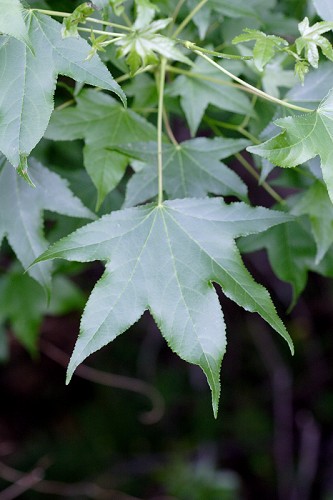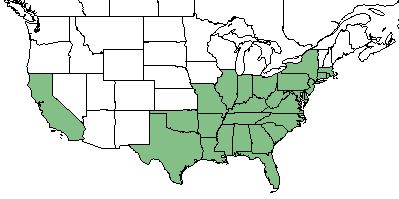Difference between revisions of "Liquidambar styraciflua"
(→Conservation and Management) |
|||
| Line 44: | Line 44: | ||
==Conservation and Management== | ==Conservation and Management== | ||
| + | ''L. styraciflua'' is listed as a species of special concern by the Connecticut Department of Environmental Protection. <ref name= "USDA Plant Database"/> | ||
==Cultivation and restoration== | ==Cultivation and restoration== | ||
Revision as of 13:39, 24 May 2018
| Liquidambar styraciflua | |
|---|---|

| |
| Photo by the Southeastern Flora Database | |
| Scientific classification | |
| Kingdom: | Plantae |
| Division: | Magnoliophyta - Flowering plants |
| Class: | Magnoliopsida - Dicots |
| Order: | Hamamelidales |
| Family: | Hamamelidaceae |
| Genus: | Liquidambar |
| Species: | L. styraciflua |
| Binomial name | |
| Liquidambar styraciflua L. | |

| |
| Natural range of Liquidambar styraciflua from USDA NRCS Plants Database. | |
Contents
[hide]Taxonomic Notes
Synonyms: none
Varieties: none
Description
L. styraciflua is a perennial tree of the Hamamelidaceae family native to North America. [1]
Distribution
L. styraciflua is found in the southeastern corner of the United States from Texas to Massachusetts, as well as California. [1]
Ecology
Habitat
L. styraciflua is found in swamp forests, floodplains, moist forests, depressional wetlands, old fields, and disturbed areas. [2]
Phenology
L. styraciflua flowers February, March, and May. [3]
Fire ecology
L. styraciflua is not fire resistant and has low fire tolerance. [1]
Use by animals
L. styraciflua has medium palatability for browsing animals [1], and the bark is a favorite food of beavers. Additionally, the sap used to be gathered as chewing gum. [2]
Conservation and Management
L. styraciflua is listed as a species of special concern by the Connecticut Department of Environmental Protection. [1]
Cultivation and restoration
Photo Gallery
References and notes
- ↑ Jump up to: 1.0 1.1 1.2 1.3 1.4 USDA Plant Database https://plants.usda.gov/core/profile?symbol=LIST2
- ↑ Jump up to: 2.0 2.1 Weakley, A. S. (2015). Flora of the Southern and Mid-Atlantic States. Chapel Hill, NC, University of North Carolina Herbarium.
- Jump up ↑ PanFlora Author: Gil Nelson URL: http://www.gilnelson.com/PanFlora/ Date Accessed: 5/24/18